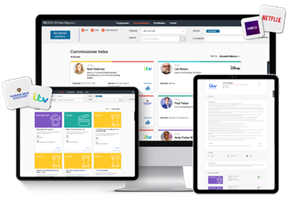 Sponsored content
Sponsored content
Scottish production accountant Gerry Tyrrell describes how Accounts Payable Automation, the newest feature within Sargent-Disc’s Digital Production Office platform, freed up time on his latest production
It is two years since Gerry Tyrrell moved into the screen industry after more than 25 years in industry and commerce accounting. Since transitioning (via an NFTS Diploma for Production Accounting & High-End Television), the Scottish-produced credits he’s worked on have included Netflix thriller Department Q and Brian Cox’s directorial debut Glenrothan.
More recently, he’s wrapped on Mint, the darkly comic, unconventional BBC drama by House Productions and Fearless Minds. Shot in Glasgow, it marks the TV debut of Baftanominated filmmaker Charlotte Regan (Scrapper).
“One parallel between the screen industry and others I’ve worked in, is the importance of engaging with people in non-finance teams, to get the best for you, the production and the company behind you,” he says. “I firmly believe that working in finance or accounts, you need to add value – and you can do that by applying your knowledge and experience to reading into the financials, or partnering with people outside of accounts.”
“Too often, you see finance following manual processes that haven’t changed for decades. That’s got to change. AP integration presents an opportunity”
Gerry Tyrrell
A longstanding champion of digital technology, Tyrrell has never shied away from trialling new tools to increase efficiency. “I first worked with APA add-ins about 10 years ago and found them really effective. However, at the time, the licensing costs weren’t justifiable, even on the high-volume engineering or manufacturing projects I was working on.
“One of the biggest positives of the new APA functionality for Sargent-Disc’s DPO and PSL is that it’s affordable and therefore more accessible. I tried to get it in place on my last two jobs, without success. So when the Mint job came along, I said: ‘Yes, we’re doing this!’”
As the industry strives for faster delivery, and ‘time to market’ becomes compressed, it’s not unusual for different departments to embrace technology to help them move quicker. “Yet too often, you still see finance following manual processes that haven’t changed for decades,” says Tyrrell. “That’s got to change. AP integration presents an opportunity.”
Time-saving benefits
The biggest benefit of APA, according to Tyrrell, is the time it gives back. “The functionality frees up so much capacity that your team are able to add value in other ways, while also mitigating risk for the production and wider business.
“It allows us to work smarter and apply ourselves elsewhere, to create bandwidth and apply strategic insight at every stage – whether that’s during production, when we can take a couple of steps closer to business partnering – or afterwards, when we can be preparing handover packs or files to support audit.”
Benefits reach beyond the accounts team, he says. Managers and HoDs can review and approve invoices remotely more easily, without juggling multiple platforms or losing notifications in busy inboxes. “People need space to be creative and deliver, even when their own remit is under pressure. APA helps by removing a lot of distractions and follow-ups.”
Tyrrell explains the reduction in interactions, or ‘touches’ an invoice requires using APA. “For Mint, we touched the invoice once during the process” he says. “Upon receipt, it went through the validation, matching and approval process online, with final invoice seamlessly interfaced back into the Ledger into a ‘batch pending’ posting.”
On a previous job where APA was not used, he estimates that a similar invoice needed to be ‘touched’ at least 10 times, in order to be moved in and out of the various systems required between raising a PO and invoicing.
“There’s nothing actually wrong with that process,” says Tyrrell. “Invoices get paid – it just takes a massive amount of time and resource to support, especially when production has built up a head of steam and is running at pace.”
With streamlining comes increased efficiency. “On previous jobs, getting 30 invoices approved per week for a payrun was a win. On Mint, we were processing more than 200. All received, reviewed, approved and processed during the normal course of business, while managing other aspects of accounts’ deliverables, including wider risk mitigation.”
For Tyrrell, it’s tools like these that are helping productions keep pace. “Producers continue to look to Scotland because the people consistently deliver high-calibre content. The ‘can do’ attitude is more than a mindset, it’s an ethos embedded in the culture in all departments, including accounting. Digital products like these help future-proof our field of work, by aligning it with the speed of modern production.”

























